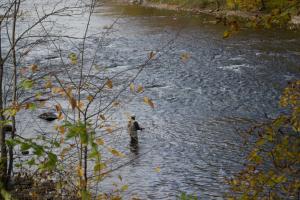Vanishing Salmon: The Knockout Blow
Commentary in the Telegraph Journal
Written by Inka Milewski, Science Advisor for the Conservation Council of New Brunswick
With catch restrictions placed on salmon anglers, thousands of volunteer hours dedicated to river and stream enhancement projects, millions of salmon released from hatcheries, and millions of dollars dedicated to research, still, wild Atlantic salmon continued to decline (Telegraph-Journal series, Downstream: Saving New Brunswick’s Salmon). A surprise? Not really.
The precipitous decline of wild Atlantic salmon observed by most in the early 1980s began decades earlier.
In the spring of 1954, clouds of DDT descended on newly hatched and one- and two-year old young salmon in the Northwest Miramichi River. DDT, a chlorinated organic pesticide, mixed with a naphtha oil was being used to combat an extensive infestation of spruce budworm throughout eastern Canada.
According to the Fisheries Research Board of Canada, now called the Department of Fisheries and Oceans, the effect of the 1954 DDT spray program on salmon in the Northwest Miramichi was devastating. None of the young salmon which had hatched that spring survived. Only one out of every six salmon that had hatched a year or more earlier survived. One third of the salmon ready to go out to sea died. The abundance of trout, eels and minnows was also affected.
The annual amount of DDT sprayed from 1952 to 1967 was 5,700 mt (12.5 million pounds).
As evidence of the negative effects of DDT on wildlife grew, new pesticides were introduced to help combat continuing infestations of spruce budworm. Fenitrothion, an organophosphate insecticide, was first used in New Brunswick in 1965. The province would become the greatest user of fenitrothion. In the 1990s, fenitrothion was de-registered by the federal government because of its adverse ecological effects.
According to Environment Canada, New Brunswick had the largest and longest-running aerial pesticide spray program in the world. Spray operations were conducted every year except 1959. A very conservative estimate of the amount of pesticides used between 1952 and 1990 to combat spruce budworm is 100,000 mt (220 million pounds). Between 1975 and 1986, a total of 19.392 million hectares (ha) of forests in New Brunswick were treated with pesticides. The only other province that came close to that figure was Quebec with 13.7 million ha followed by Newfoundland with 0.598 million ha, Nova Scotia with 0.22 million ha, and Ontario with 0.28 million ha.
Throughout those 40 years of aerial spraying, the Miramichi River watershed, along with other rivers throughout New Brunswick, were exposed to repeated applications of these pesticides. ens of thousands of tonnes of toxic chemicals were deliberately dumped on New Brunswick’s forests and streams. Rachel Carson would call the Miramichi and other rivers affected by DDT “rivers of death”.
Through her landmark book, Silent Spring, Rachel Carson brought the world’s attention to the toxic and persistent effects of pesticides like DDT on wildlife and humans. Not only did fish and insects die from immediate (acute) exposure to these chemicals but Carson identified their potential to cause long-term (chronic) effects on sexual development, cell division, and genetic replication.
The understandable hand-wringing over vanishing wild salmon in New Brunswick fails to address the knock-out blow that millions of pounds of pesticides have had on wild salmon stocks. For decades, successive year classes of salmon were obliterated by chemical bombing. It’s difficult, if not impossible, to build future healthy fish stocks when, year after year, there are no juveniles to recruit into the population or surviving juveniles have impaired immune or reproductive systems and their genes are damaged.
During the entire period of chemical spraying, government regulators were insistent that these chemicals were safe, until decades later they were proven unsafe.
Failing to acknowledge the long-term, persistent effects that pesticides have had, and continues to have, on wildlife and humans is a recipe for history repeating itself. The large-scale aerial spraying of the herbicide — glyphosate, recently classified as a carcinogen, should stop. Pesticides use to kill the chronic plague of sea lice in salmon farms should be prohibited. And, the cosmetic pesticides used to kill spiders, ants and cinch bug in our lawns, recreational areas and schoolyards should be banned.
The ultimate lesson from the history of salmon’s decline is, in the words of Rachel Carson, what we do to wildlife, we do to ourselves.
